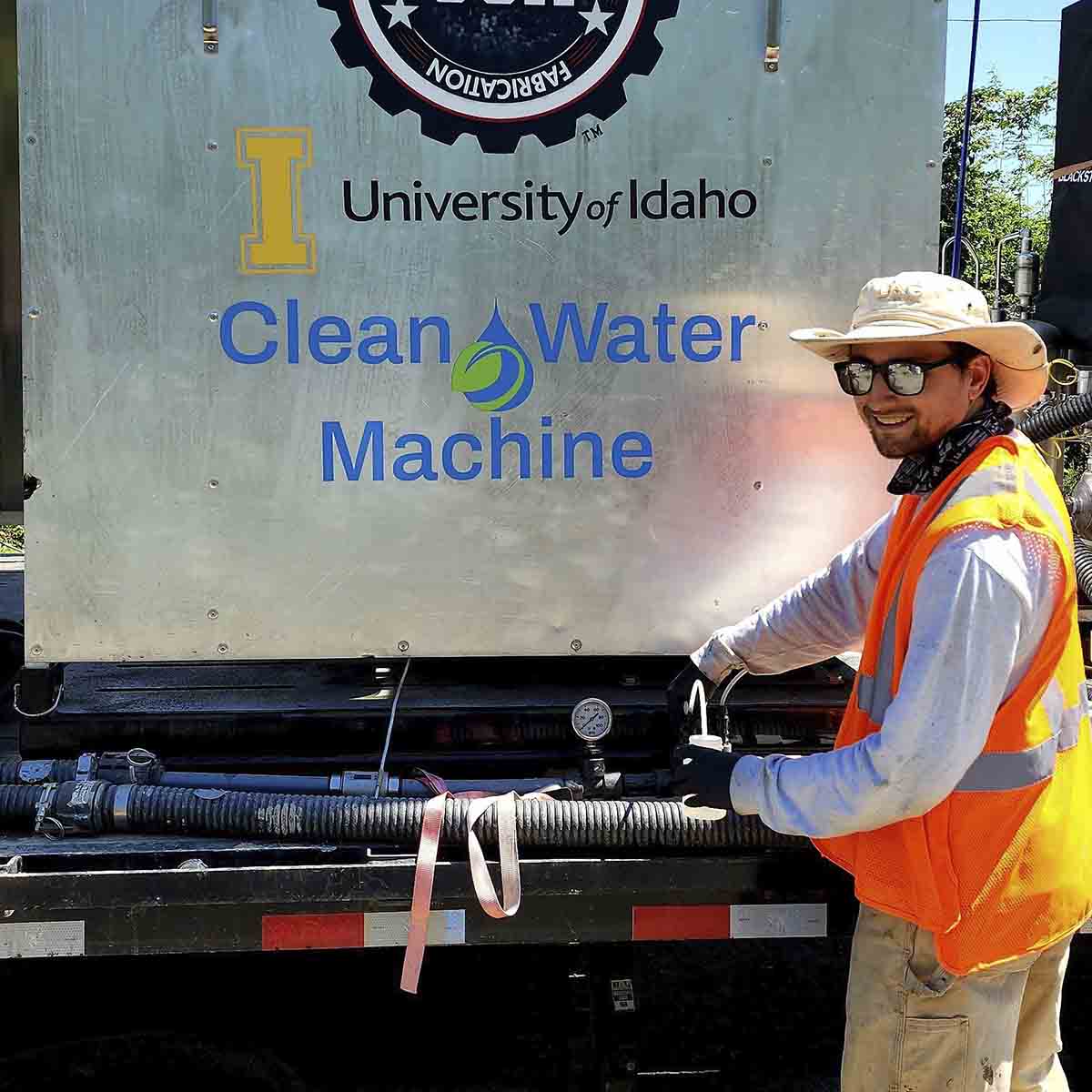Partners in Sustainability
Anheuser-Busch’s Elk Mountain Farms, located near Bonners Ferry, is renowned for its size. With 1,700 acres under trellis, it’s the world’s largest contiguous hops farm.
Elk Mountain’s operators are beginning the second year of working with researchers from University of Idaho’s College of Agricultural and Life Sciences (CALS) to earn a new distinction — as trailblazers in innovative, sustainable production practices.
In summer 2022, Elk Mountain tested U of I’s patented technology to treat shallow groundwater beneath their property and recover phosphorus. In the environment, phosphorus within a watershed may leach into surface waters and can contribute to algal blooms that deplete waterbodies of dissolved oxygen. Researchers used iron and biochar in a flow-through filter to treat the groundwater. The recovered nutrient-enriched biochar is being tested as a soils amendment to nourish and fertilize hops plants on the farm.
“There’s a finite amount of phosphorus,” said Elk Mountains manager and CALS graduate Radley Peterson, ’15, who earned a bachelor’s degree in sustainable crop and landscape systems with an emphasis in plant biotechnology. “If we can create more of a circular system there where we’re avoiding phosphorus accumulation in waterways and the depletion of phosphate mines, that’s a win-win for us.”
A CALS team — including researchers Dan Strawn, Martin Baker, Greg Möller and Alex Crump and graduate students Mike Vogler and Lusine Taslakyan — brought U of I’s pilot-scale Clean Water Machine to the site. The trailer-mounted filtration system mimics natural processes that clean water, and the technology, patented by U of I, is being used globally.
The system tested at Elk Mountain added in an additional process patented by U of I, known as reactive biochar filtration. Biochar is a type of charcoal produced from plant matter, which can also be used as a carbon-boosting soil amendment. Unused water from the farm’s subsurface drains was filtered through biochar modified to capture nutrients, before passing through a filter of iron-coated sand. Eventually, Peterson would like to produce biochar to clean water on his farm with biomass waste from hops harvest.
Peterson said Anheuser-Busch may look to implement the technology long term if analysis shows the company could recoup its investment through the value of the phosphorus it salvages, or if the technology could help the company reach one of its sustainability goals.
“As phosphorus supplies continue to be depleted, it’s a simple supply and demand curve. If it doesn’t pencil now, give it 10 more years and it could,” Peterson said. “I’m very optimistic about this technology.”
Vogler, a master’s student studying water resources, has been helping the team assess various chemical and physical modifications to the biochar to optimize phosphorus removal.
“We brought some of the modified biochars I have been working on to Anheuser-Busch when they set up the Clean Water Machine,” Vogel said. “I spent a full year in the lab just doing experiments with various iterations of my treatments and testing different variables. It was nice to go out and test it on a larger scale in a real-world application.”
The machine treated about 15 gallons of water per minute at the hops farm, and the researchers expect the data will show the process removed about 90% of phosphorus. Actual numbers on water-quality improvements and the quantity of phosphorus reclaimed should be available by fall.
Taslakyan, a doctoral candidate from Armenia studying water resources, has been modeling the environmental impact of using the technology against the environmental benefits. The process of recovering nutrients requires inputs of power and chemicals.
“The whole idea is to see where the hotspots are and how you can improve it to make it less energy intensive — how to modify the technology to make less of an environmental impact,” Taslakyan said.
This spring, the researchers will start greenhouse trials on the farm, using the recovered phosphorus-loaded biochar as a fertilizer and soil amendment in hops production.
The experiment at the hops farm is one of many applications for the filtration technology U of I researchers have been studying, supported by a $1 million federal Environmental Protection Agency grant. The CALS team has also used iterations of the system to treat water in an agricultural delivery canal, wastewater from a food processing plant and as a tertiary treatment with municipal wastewater treatment plants. Even after the final treatment stage at most municipal wastewater facilities, effluent often retains high levels of phosphorus. The machine “polishes” the effluent to remove most of it.
“We can really treat the wastewater to have super-low effluent phosphorus concentrations,” said Strawn, the project’s co-principal investigator and a professor of environmental soil chemistry. “At the same time, now that we’ve recovered that phosphorus, what are we going to do with it? Treatment costs money. We may be able to offset that by creating value-added products.”
A separate $10 million USDA grant that the team is working on is supporting research using biochar to capture phosphorus from dairy lagoon water, among other technologies aimed at improving dairy sustainability. U of I can also add a process known as ozone catalytic oxidation into treatments to break down bacteria in dairy effluent, as well as pharmaceuticals that may linger in treated municipal wastewater.
The project at the hops farm is one of many research projects testing the technology under a grant titled “Phosphorus Removal to Oligotrophic Levels: Innovating Three High-Flow Water Technologies using Reactive Filtration, Biochar Adsorption and Nanobubble-Enhanced Biomimetic Separations.” It is funded under the U.S. Environmental Protection Agency grant No. R84008701. The total project funding is $1 million, of which 100% is the federal share.

Article by John O’Connell, College of Agricultural and Life Sciences
Photos provided by Greg Möller
Published in April 2023







